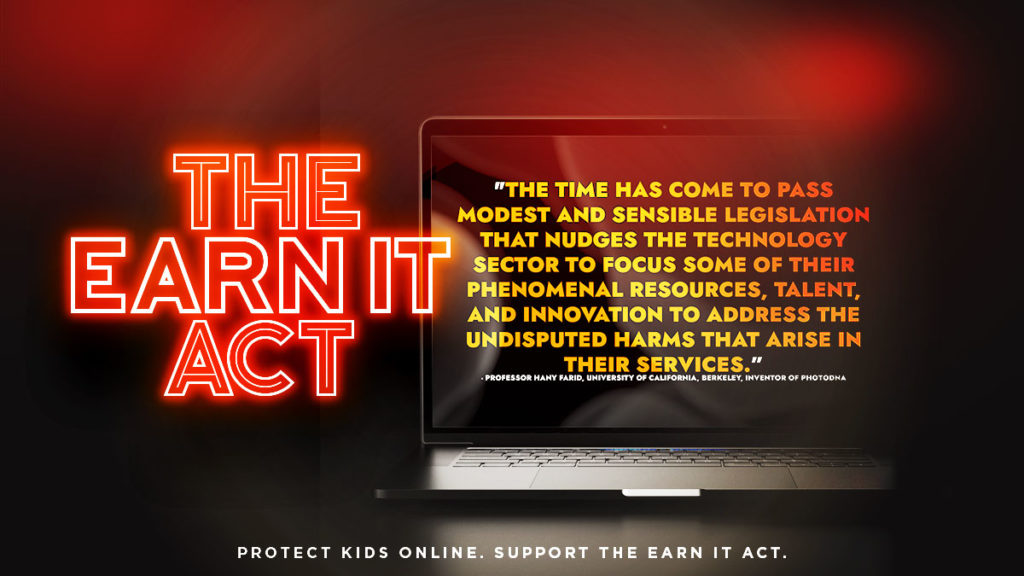Why Tech Companies Should Support the EARN IT Act
Living in a world that is so heavily fixated on technology comes with its own consequences. Recent generations have grown up in the digital realm and most children are now immersed in it from a very early age. As it stands right now, children face an ever-increasing risk of being groomed and exploited online as perpetrators use social media platforms—among other digital mediums—to target and groom children. This and other factors have played a significant role in the exponential growth of the amount of child sexual abuse material (CSAM) circulating online.
Common misunderstandings and myths about the EARN IT Act are explained below, but the simplest way to understand the EARN IT Act is to note what it actually does:
- The EARN IT Act allows survivors of child sexual abuse material to restore the privacy they have lost because their abuse was uploaded to the Internet.
- The EARN IT Act clarifies that there is not now—nor has there ever has been—immunity for digital platforms that knowingly disseminate child sexual abuse material.
- The EARN IT Act changes the term “child pornography” in federal statue to “child sexual abuse material” to ensure that it is treated as evidence of a crime.
- The EARN IT Act creates a new online child exploitation prevention committee with oversight from Congress.
- The EARN IT Act clarifies the right of consumers in regard to holding technology companies accountable for knowingly disseminating child sexual abuse material.
Understanding the Scope of the Problem the EARN IT Act is Addressing
In 2008, there were over 600,000 reports of CSAM made to the National Center on Missing and Exploited Children (NCMEC). These numbers were significant enough for the organization to call the problem what it was: an epidemic. Horrifically, the number of reports of CSAM received by NCMEC has multiplied exponentially in the decade since and the organization reported receiving over 70,000,000 reports of CSAM in 2019 alone.
Some of the most popular social media platforms—such as Instagram and Twitter—are furthering the problem by not reporting abuse found on their websites, and technology companies have long attempted to use Section 230 of the Communications Decency Act (CDA 230) to hide from accountability. CDA 230, which was implemented in 1996, was intended to help foster growth in the early stages of the Internet but has since been wrongly interpreted by Interactive Computer Services (ICS) as an excuse to not work proactively to prevent exploitation found on and/or perpetrated via their online products. CDA 230 was never intended to protect sex traffickers or child predators online nor was it meant to allow CSAM (sometimes inaccurately referred to as “child pornography”) to run rampant in online spaces.
The EARN IT Act Means Clarity for Tech Companies and a Path to Justice for Survivors
Since its introduction, lobbyists representing portions of the technology industry have attempted to make misleading claims about the intent and impact of the EARN IT Act with hopes of preserving profit margins for tech behemoths that don’t want to spend money to make their online products safer. The claims they make are alarmist red herrings and do not actually address the structure or contents that make up the EARN IT Act. Below are several of the most common false claims/myths about the EARN IT Act and the reality behind them that show why the EARN IT Act is actually a good thing for consumers and the technology industry itself.
Myth #1: The EARN IT Act is an attack on end-to-end encryption and user privacy
Truth #1: Many tech companies are pushing back on the EARN IT act, claiming that it is an invasion to user privacy and will bring on more trouble involving mass surveillance. However, this is not the case.
The EARN IT act would implement new ways to combat CSAM on their platforms as technology continues to advance. Furthermore, tech companies are already capable of acquiring information on what is said and done on their programs, so why not implement the same technology to recognize and report CSAM when detected? Many of the safety features on these platforms would be directed toward helping children without infringing upon any freedoms of adults. It would hold these companies accountable for what is being shared even if the content came from a third-party user. This bill will incentivize tech companies to report and eliminate any CSAM they come across it on their platforms and is not an attack on end-to-end encryption and user privacy.
Myth #2: The EARN IT Act will eradicate Section 230 of the Communications Decency Act (CDA 230)
Truth #2: Far from harming CDA 230, the EARN IT Act actually helps clarify its original intent.
CDA 230 does not give technology companies immunity from accountability for participating in and/or profiting from crimes such as sex trafficking and CSAM. CDA 230 was created at a time when the internet was still in its developing stages and Congress was attempting to foster its growth, but it never gave technology companies the right to knowingly ignore or facilitate crimes such as sex trafficking and CSAM as they have tried to claim.
Mary Leary, professor of law at the Catholic University of America put it this way in a virtual Congressional Briefing: “The EARN IT act, I would argue, actually restores CDA 230 to the original intent of Congress as a component of an ecosystem that will better protect children.”
Today, there is widespread access to the internet and children are facing the consequences of online spaces which have not been built as adequately secured and protected environments. The EARN IT Act is not a threat towards CDA 230 but is, instead, a measure which will clarify the law and allow CDA 230 to operate as it was originally designed to do.
Myth #3: The EARN IT Act is an undemocratic way for the government to control the technology industry via burdensome regulations
Truth #3: The EARN IT Act is being introduced and vetted—and is built to be implemented—via established Constitutional processes.
If passed, it includes the building of an Online Child Exploitation Prevention Commission made up of a diverse group of survivors of CSAM, technology industry representatives, law enforcement officials, privacy experts, and more. Because technology is always growing and morphing, the Commission will help guide and direct businesses and corporations in terms of policy. The Commission’s goal is to develop recommended best practices that interactive computer service providers can use to prevent, reduce, and respond to online child sexual exploitation, such as enticement, grooming, sex-trafficking, and sexual abuse, as well as the proliferation of online child sexual abuse material.
These best practices are recommendations, not mandates, and will be vetted and voted upon using established democratic processes in Congress. Technology companies would have the option to adopt those practices, but there is not punishment prescribed if they choose not to do so. In this regard, the EARN IT Act just clarifies that survivors do in fact have a path to justice available to them.
Myth #4: The EARN IT Act will threaten online speech and privacy rights for LGBTQ people and other marginalized communities
Truth #4: First things first, sex trafficking and child sexual abuse material never have been, are not now, and never should be protected categories of free speech. Secondly, the EARN IT Act does not contain—and is actually designed to prevent—any development of measures that would identify or target or collect data about users or groups of users.
As noted previously, the EARN IT Act establishes a diverse commission which will develop recommended (again, not mandated) best practices that will then have to be democratically vetted and voted on before they are made official as recommended best practices. This design is intentional for, among other things, preventing the EARN IT Act from being quietly co-opted to target any person or group. In fact, because they are disproportionately affected by online sexual abuse and exploitation, the EARN IT Act will make the Internet a safer space for LGBTQ people and other marginalized communities.
Myth #5: The court’s decision to allow Doe v MindGeek to progress past the motion to dismiss shows that the EARN IT Act isn’t necessary
Truth #5: The judge’s ruling in Doe v MindGeek was important and precedent-setting, and the fact that it was precedent-setting is a case-in-point for why the EARN IT Act is still necessary.
The judge ruled correctly that CDA 230 was never meant to protect technology companies from being held accountable for knowingly possessing and distributing child sexual abuse material, but there have been too many erroneous rulings on that matter in previous cases due to confusion in the courts. The EARN IT Act is designed to, among other things, address that confusion by clarifying the original intent of CDA 230 so that survivors are able to have a path to justice that has been closed on them incorrectly and unfairly in the past. The EARN IT Act is a democratic way that Congress can help ensure accurate and consistent application of existing laws moving forward.
The EARN IT Act Respects People, Incentivizes Technology Companies to Put Customers First, and Prioritizes Justice for Survivors
We believe that technology companies and the tech industry at large should want to support the EARN IT Act if they truly have their customers’ best interests in mind. The EARN IT Act will help prevent the continued proliferation of CSAM, restore the intended protections of CDA 230, clarify the right to justice for survivors of CSAM, and empower consumers. These outcomes are beneficial to U.S. citizens and businesses alike. That is why the EARN IT Act is a bipartisan bill that should be easy to support.

Take Action
If you are moved to create an environment that protects children from sexual exploitation online, you can click here to send a message to your members of Congress to support the EARN IT Act. It only takes a little bit of your time to reach out and make a big difference for children.



